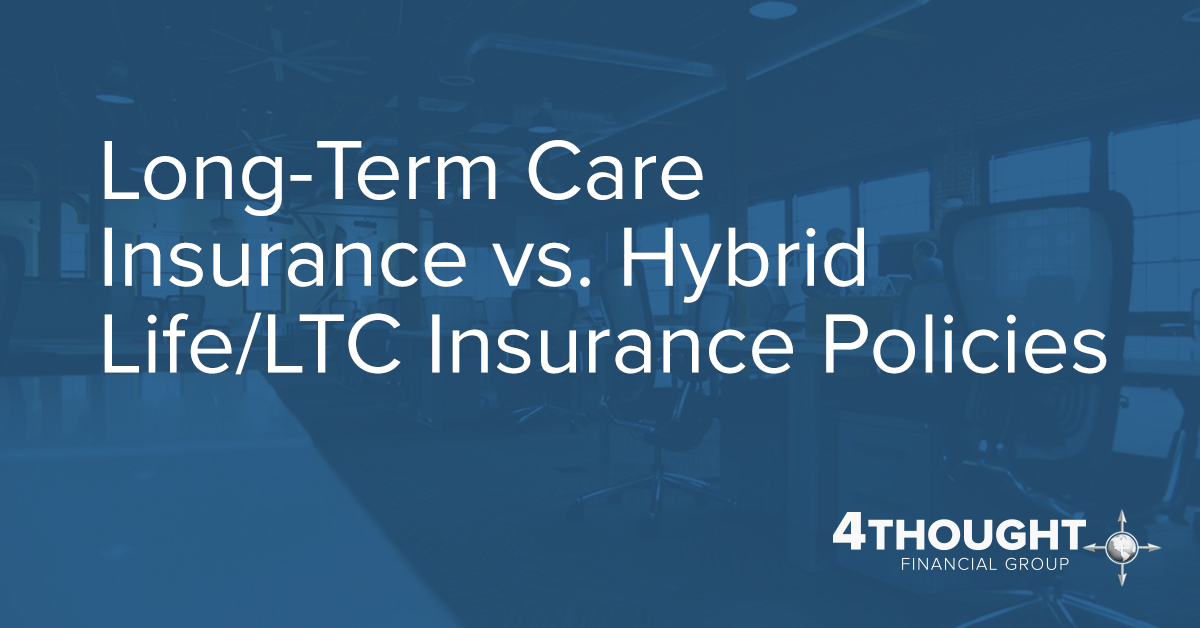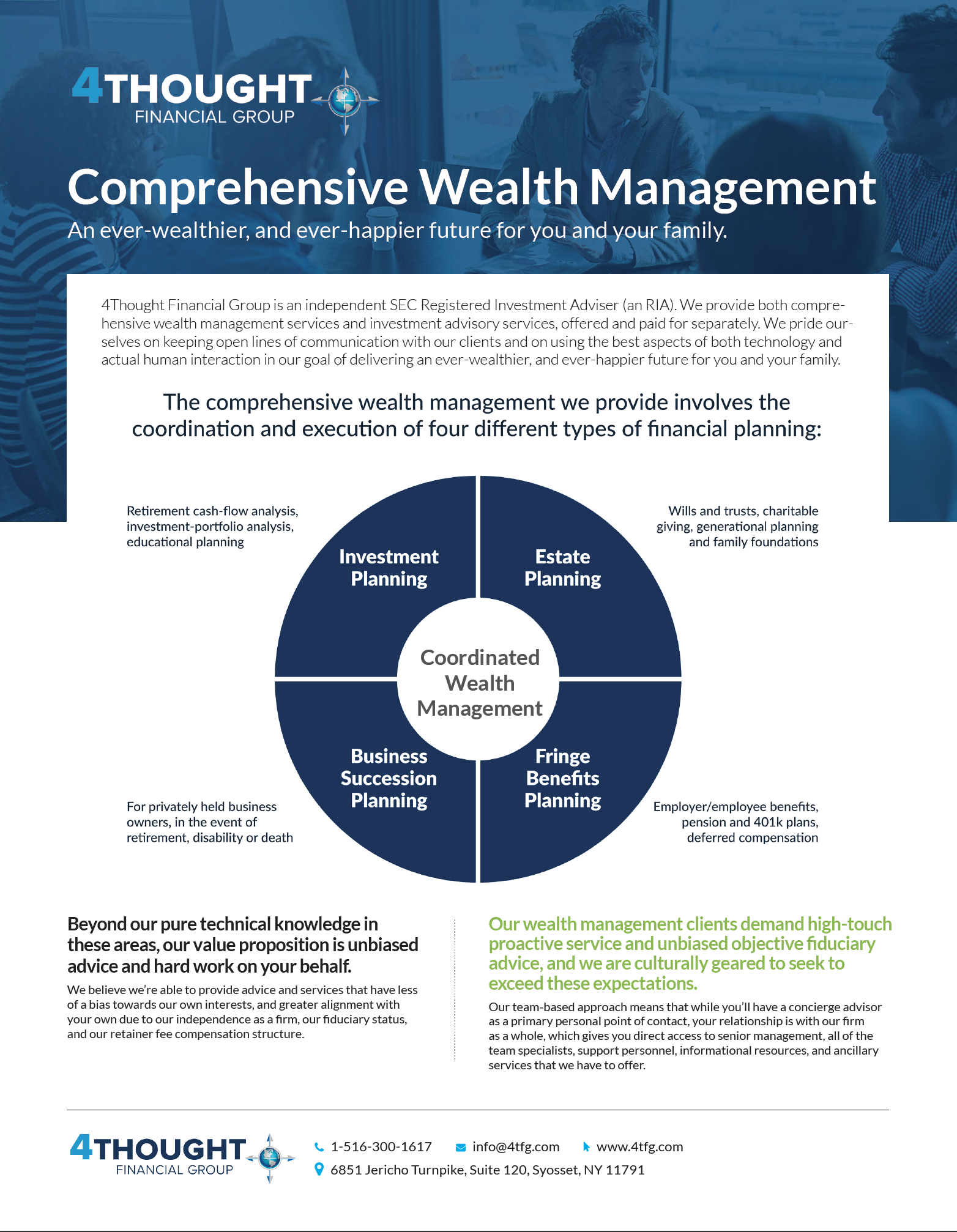

Wealth Management by 4Thought Financial Group
"The comprehensive wealth management we provide involves the coordination and execution of four different types of financial planning: Investment Planning, Estate Planning, Business Succession Planning and Fringe Benefit Planning."
Having been in the life and health insurance industry since 1984, I have become skeptical when insurance companies include language in the fine print such as: “may be,” “ordinarily excluded,” “check with your tax advisor,” or “the rider is not long-term care insurance and is not intended to replace long-term care insurance.”
Why are those disclosures included within hybrid life insurance and long-term care policy contracts? Do we have to find out at claim time exactly how they apply? The purpose of this article is to address some of these issues.
First, a little personal background. The first long-term care insurance policy I sold was to my mother in 1988. The maximum daily benefit offered at the time was $50 per day. Almost 20 years later, when my own mother was denied a long-term claim because the facility did not qualify, I was beside myself. The legal language in the old policies was very limited as to facility definitions relative to today’s policies. The policy did finally pay benefits for home health care as my Mom became elderly.
With the help of a little history, let’s take a closer look at how these hybrid life and long-term care policies came about. Starting in the 1980s, the only type of policies available were individual long-term care policies. Hybrids did not exist. After the AIDS/HIV epidemic (also in the 1980s), life insurance companies were pressured to accelerate the death proceeds of the life insurance policies if the insured was terminally ill (if certified by a physician that death will occur within 12 months). Insurance companies knew they would eventually pay the death claim, and with public sentiment for the victims and their families mounting, many companies opted to accelerate the payment of the death benefit. This was also the beginning of the life settlement business, which is when life insurance policies on terminally ill policyholders (and now chronically ill policyholders) who need money immediately are purchased by third-party investors.
The insurance industry started to sell many varieties of policies starting in the 1990s to senior citizens. It was a very confusing time for seniors to try and differentiate what each policy covered and if there was any overlap between the policies. The Health Insurance Portability and Accountability Act of 1996 (HIPAA) changed all that. Specific language was now mandatory on all new long-term care contracts sold by insurance companies regarding the requirements for an insured to start a claim and receive benefits. HIPAA established that policies had to include specific language to “tax-qualify” the premium and benefits for favorable income tax treatment. The language in the insurance contract now had to include that the insured was not able to perform two out of six activities of daily living (ADLs) or had a cognitive impairment. This opened the flood gates for the insurance companies to sell large amounts of long-term care policies.
Unfortunately, most of the companies underpriced the policies and had to pay many more claims than they originally anticipated. The result was large premium increases. Within the last decade, many of these insurance companies either stopped selling new polices, increased the premium on new or existing policies, or both. Newer policies have also been repriced, with higher premiums and less benefits. For example, the premium for women is higher than men, since statistically they live longer. This was previously never done before.
The bottom line is that stand-alone long-term care policies are more expensive than hybrid life/LTC policies. They also have more bells and whistles attached to fund future benefits. Their downside is that if you never have a claim, you paid all these premium and got nothing in return. With the hybrid policy, the life insurance benefit would be paid at death, so hence all your premiums would have been returned (less any claims that have been paid). One downside of many hybrid policies is that often, the bulk of or all of the premium must be paid up front in a lump sum, or during a short period of time. There are basically two types of hybrid policies that are under various sections of the Internal Revenue Code. One has a separate rider/cost, and one incurs the cost at the end when the benefit is paid. Some are also “expense reimbursement,” and some are “indemnity.” As always, on closer examination with all these hybrid types, the insurance companies have made the policies very complicated and confusing.
This is a classic “it depends” answer to the question of which policy is right for you. It’s important to choose an advisor who has knowledge of this type of insurance and can explain the advantages and disadvantages of each policy.
Buyer beware. One size does not fit all.
A tax advisor should also be consulted to clarify the tax treatment of potential benefits for the hybrid policies that are paid out on claim. Some of the benefits could potentially be taxable.
4Thought Financial Group
For more information on the above and to review budgeting and cash flow needs, please contact 4Thought Financial Group at info@4tfg.com for additional information on how to best plan for your financial future.








Leave a Comment